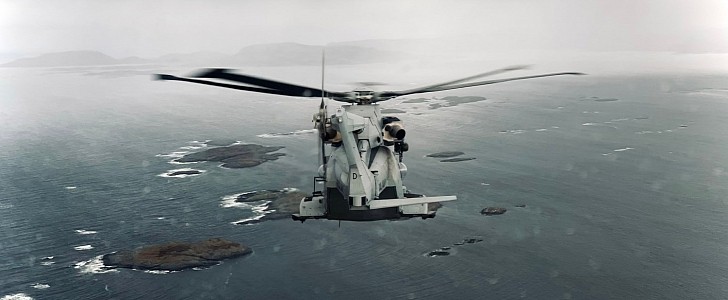A fleet of Merlin and Wildcat helicopters from the Royal Marines has arrived in the High North, ready to assist their commando comrades. To reach their final destination, the aircraft had to travel up to 1,800 miles (2,897 kilometers), facing the harsh environment of the Arctic.
Three Merlins of 845 Naval Air Squadron and four Wildcats from 847 NAS started their journey from their base at Yeovilton. The helicopters flew over England, Scotland, the North Sea, and up to Norway's west coast before arriving at Royal Marine's training base in Bardufoss.
Usually, someone who covers this route only spends a few hours to get to Bardufoss – if they get there by car and plane. But navigating through snow showers and storms in sub-zero temperatures is not an easy task when you're piloting a military helicopter that needs refueling every three to four hours.
In total, it took five days for the aircrew and engineers to arrive deep inside the Arctic Circle. During this time, pilots had to battle strong winds and extreme temperatures while flying over hilly terrain.
"The Arctic has offered us little respite from the outset with the inclement weather we've experienced," said Lieutenant Commander Tom Nason, the detachment commander.
"Thankfully, despite these conditions it took little time for both our aircrew and engineers to reacclimatise; lessons have been quickly re-learnt with the 'old guard' coming to the fore to guide those experiencing their first taste of this majestic region."
Two pilots, two aircrewmen, and five engineers were onboard each Merlin. The crew worked together to make sure that everything worked accordingly, even in the cold climate. In Brønnøysund, the engineers installed protective severe cold weather covers over the helicopters, which proved to be essential.
According to the Royal Navy, the Wildcats and Merlins will stay in Bardufoss until April. During this time, they'll work with the Royal Marines and Apaches of the Army Air Corps. Next month, they'll also train with international participants in Cold Response – Norway's largest military exercise in more than three decades.
Usually, someone who covers this route only spends a few hours to get to Bardufoss – if they get there by car and plane. But navigating through snow showers and storms in sub-zero temperatures is not an easy task when you're piloting a military helicopter that needs refueling every three to four hours.
In total, it took five days for the aircrew and engineers to arrive deep inside the Arctic Circle. During this time, pilots had to battle strong winds and extreme temperatures while flying over hilly terrain.
"The Arctic has offered us little respite from the outset with the inclement weather we've experienced," said Lieutenant Commander Tom Nason, the detachment commander.
"Thankfully, despite these conditions it took little time for both our aircrew and engineers to reacclimatise; lessons have been quickly re-learnt with the 'old guard' coming to the fore to guide those experiencing their first taste of this majestic region."
Two pilots, two aircrewmen, and five engineers were onboard each Merlin. The crew worked together to make sure that everything worked accordingly, even in the cold climate. In Brønnøysund, the engineers installed protective severe cold weather covers over the helicopters, which proved to be essential.
According to the Royal Navy, the Wildcats and Merlins will stay in Bardufoss until April. During this time, they'll work with the Royal Marines and Apaches of the Army Air Corps. Next month, they'll also train with international participants in Cold Response – Norway's largest military exercise in more than three decades.






